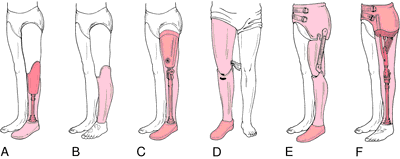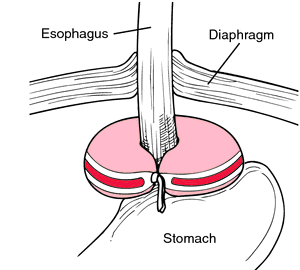Medical term:
prothetic
prosthesis
[pros-the´sis] (pl. prosthe´ses) (Gr.)an artificial substitute for a missing part, such as an eye, limb, or tooth, used for functional or cosmetic reasons, or both.
Artificial Limb. Advances in the field of surgical amputation and the art of designing artificial limbs have made it possible for persons who have lost a limb to be equipped with a prosthesis that functions so efficiently, and so closely resembles the original in appearance, that they can resume normal activities with the disability passing almost unnoticed.
Materials Used in the Prosthesis. A variety of materials can be used for the manufacture of artificial limbs. Wood, especially willow, is the most popular because it is comparatively light and resilient, and is easily shaped. Aluminum or an aluminum alloy is used when lightness is particularly desirable, such as in a limb for an aged person. Plastic limbs are also available. Leather and various metals are used for reinforcement and control.
Powering the Limb. Most artificial limbs are powered by the muscles, either those remaining in the residual limb or other available muscles. The muscles of the residual limb often can be considerably strengthened by physical therapy. Muscle power can be reinforced by means of springs, straps, gears, locks, levers, or, in some cases, hydraulic mechanisms.
The Artificial Lower Limb. The most commonly fitted artificial limb is the knee-jointed leg, used by persons whose lower limbs have been amputated above the knee. This prosthesis is powered by the hip and remaining thigh muscles, which kick the leg forward. The key points in such a limb are the socket, where it fits onto the residual limb, the knee, and the ankle. The possibility of walking with a normal gait depends primarily on the successful alignment of the socket joint; the knee usually consists of a joint centered slightly behind that of the natural leg, as this has been found to afford greater stability; sometimes the ankle joint is omitted and flexibility of the ankle achieved by the use of a rubber foot.
The Artificial Upper Limb. The choice of a particular artificial upper limb depends largely on the person's occupation. There are many different types, ranging from the purely functional, which will enable a person to perform heavy work, to the purely cosmetic, which aims only at looking as natural as possible. Those persons whose work requires them to do heavy lifting are often fitted with a “pegarm,” a short limb without an elbow joint, which is easily controlled and has great leverage.
The Artificial Hand. There are many different types of artificial hands. Many artificial upper limbs are so constructed that they can be fitted with a selection of different hands, depending on the type of work to be done. Researchers generally agree that the various types of hooks offer the greatest functional efficiency. These reproduce the most powerful function of natural hands—the pressure between thumb and forefinger. There are also artificial hands that combine a certain amount of utility with cosmetic value, often by means of a cosmetic glove covering a mechanical hand; others are designed simply for appearance, though they may offer some support as well.
Most hooks and hands are mechanically connected to the opposite shoulder and operated by a shrugging motion. However, a procedure known as kineplasty uses the person's own arm and chest muscles to work the device. In this method, selected muscles are tunneled under by surgery and lined by skin. Pegs adapted to the tunnels can then be made to move an artificial hand mechanism. Kineplasty is used when skill rather than strength is desired.
Most hooks and hands are mechanically connected to the opposite shoulder and operated by a shrugging motion. However, a procedure known as kineplasty uses the person's own arm and chest muscles to work the device. In this method, selected muscles are tunneled under by surgery and lined by skin. Pegs adapted to the tunnels can then be made to move an artificial hand mechanism. Kineplasty is used when skill rather than strength is desired.
Protecting the Residual Limb (Stump). In a person with an artificial limb, there is always a danger of irritation or infection. A sock is worn to cover the residual limb, and this should be washed daily; the residual limb itself should also be washed regularly and carefully, particularly between skin folds. When the artificial limb is not being used, the residual limb should be exposed to the air if possible.

Types of lower limb prostheses. A, Below-knee endoskeletal prosthesis. The strength is derived from the inner endoskeleton. B, Below-knee exoskeletal prosthesis. The strength is derived from the outer exoskeleton. C, Above-knee endoskeletal prosthesis. D, Above-knee exoskeletal prosthesis. Exoskeletal (E) and endoskeletal (F) hip disarticulation prostheses. From Myers, 1995.
Angelchik prosthesis a C-shaped silicone device used in the management of reflux esophagitis; it can also be placed around the distal esophagus during a laparotomy. ( )
)

Placement of the Angelchik antireflux prosthesis. From Ignatavicius and Workman, 2002.
Austin Moore prosthesis a metallic implant used in hip arthroplasty.
Charnley prosthesis an implant for hip arthroplasty consisting of an acetabular cup and a relatively small femoral head component that form a low-friction joint.
penile prosthesis see penile prosthesis.
Miller-Keane Encyclopedia and Dictionary of Medicine, Nursing, and Allied Health, Seventh Edition. © 2003 by Saunders, an imprint of Elsevier, Inc. All rights reserved.
pros·the·sis
, pl.pros·the·ses
(pros'thē-sis, -sēz; pros-thē'sis),Fabricated substitute used to assist a damaged or replace a missing body part; or to augment or stabilize a hypoplastic structure.
[G. an addition]
Farlex Partner Medical Dictionary © Farlex 2012
prosthesis
(prŏs-thē′sĭs)n. pl. prosthe·ses (-sēz)
1. An artificial device used to replace a missing body part, such as a limb, tooth, eye, or heart valve.
2. Replacement of a missing body part with such a device.
The American Heritage® Medical Dictionary Copyright © 2007, 2004 by Houghton Mifflin Company. Published by Houghton Mifflin Company. All rights reserved.
Segen's Medical Dictionary. © 2012 Farlex, Inc. All rights reserved.
prosthesis
plural, prostheses Medtalk An artificial body part–eg, pseudobreast, artificial limb, etc. See Bioprosthesis, Heart valve prosthesis, Hemobahn endovascular prosthesis, Neural prosthesis, Seagull wing prosthesis.McGraw-Hill Concise Dictionary of Modern Medicine. © 2002 by The McGraw-Hill Companies, Inc.
pros·the·sis
, pl. prostheses (pros-thē'sis, -sēz)Fabricated substitute for a diseased or missing part of the body.
[G. an addition]
Medical Dictionary for the Health Professions and Nursing © Farlex 2012
prosthesis
Any artificial replacement for a part of the body. Prostheses may be functional or purely cosmetic and may be permanently installed internally or worn externally. The range of prosthetic devices is wide-from artificial eyes and legs to heart valves and testicles.Collins Dictionary of Medicine © Robert M. Youngson 2004, 2005
Prosthesis
A synthetic replacement for a missing part of the body, such as a knee or a hip.
Mentioned in: Congenital Amputation, Joint Replacement, Orthopedic Surgery, Peyronie's Disease
Gale Encyclopedia of Medicine. Copyright 2008 The Gale Group, Inc. All rights reserved.
pros·the·sis
, pl. prostheses (pros-thē'sis, -sēz)Fabricated substitute used to assist a damaged or replace a missing body part.
[G. an addition]
Medical Dictionary for the Dental Professions © Farlex 2012
Latest Searches:
vagabonds' - VAG - vadum - VADs - Vademin - VAD - vacuus - vacuum - vacuome - vacuolization - vacuoles - vacuole - vacuolating - vacuolated - vacuolate - vacuolar - vacuo - Vaculance - VACTERL - Vacora -
- Service manuals - MBI Corp